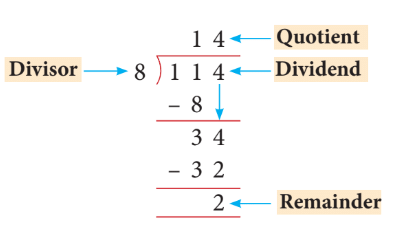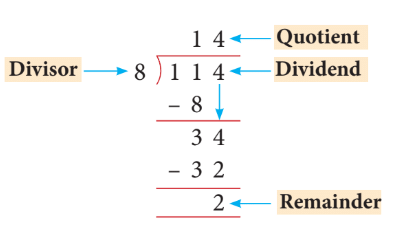Class 4 Maths - Division - CBSE Worksheets Solutions
| Table of contents |

|
| Multiple Choice Questions |

|
| Fill in the Blanks |

|
| True or False |

|
| Answer the following questions |

|

Multiple Choice Questions
Q1: What is the number to be divided called?
(a) Divisor
(b) Quotient
(c) Dividend
(d) Remainder
Ans: (c) Dividend
 The number to be divided in a division operation is called the Dividend. For example, in 114 ÷ 8, the number 114 is the dividend.
The number to be divided in a division operation is called the Dividend. For example, in 114 ÷ 8, the number 114 is the dividend.
Q2: What is the result of the division called?
(a) Dividend
(b) Divisor
(c) Quotient
(d) Remainder
Ans: (c) Quotient  The result of a division operation is called the Quotient. For example, in 114 ÷ 8, the number 14 is the quotient.
The result of a division operation is called the Quotient. For example, in 114 ÷ 8, the number 14 is the quotient.
Q3: Which of the following statements is true about dividing a number by itself?
(a) The result is the number itself.
(b) The result is always 1.
(c) The result is zero.
(d)The result is the dividend.
Ans: (b) The result is always 1
When a number is divided by itself (except zero), the result is always 1. For instance, 8÷8 = 1.
Q4: What happens when you divide zero by a non-zero number?
(a) The result is 1.
(b) The result is 0.
(c) The result is undefined.
(d) The result is the divisor.
Ans: (b) The result is 0.
When zero is divided by any non-zero number, the result is always 0. For example, 0÷5 = 0.
Q5: What is the remainder when 10 is divided by 3?
(a) 1
(b) 2
(c) 3
(d) 0
Ans: (a) 1
When 10 is divided by 3, the division gives a quotient of 3 and a remainder of 1. This is because 10 = (3×3) + 1.
Fill in the Blanks
Q1: The number left after division is called __________.
Ans: "Remainder"
Q2: When dividing a number by 1, the quotient is __________.
Ans: "The number itself"
Q3: The formula to verify division is __________.
Ans: "Divisor × Quotient + Remainder = Dividend"
Q4: The quotient of any number divided by itself is __________.
Ans: "1"
Q5: If you divide zero by a number, the result is __________.
Ans: "0"
True or False
Q1: Division by zero is defined.
Ans: "False"
Division by zero is not defined because no number can be divided by zero in mathematics. It leads to an undefined result. Hence, the statement is False.
Q2: The remainder can be equal to the divisor.
Ans: "False"
The remainder in a division operation is always less than the divisor. For example, in 10÷3, the remainder is 1, which is less than 3. Hence, the statement is False.
Q3: Division of a number by 1 always results in the number itself.
Ans: "True"
Q4: The quotient of any number divided by itself is always greater than one.
Ans: "False"
When a number is divided by itself (except zero), the quotient is always 1. For instance, 5÷5=1, which is not greater than one. Hence, the statement is False.
Q5: To divide by 10, you remove the last digit. __________
Ans: "True"
Answer the following questions
Q1: I want to distribute Rs 3,600 among 8 persons. How many rupees will each person get?
Ans:
Total Rs. = 3600
To be distributed among = 8 persons
3600 ÷ 8 = 450 Rs. per person
Q2: In a division, divisor = 100, quotient = 25 and remainder = 75, find the dividend.
Ans:
Divisor = 100, Quotient = 25 and Remainder = 75
Dividend = Quotient x Divisor + Remainder.
Dividend = 25 x 100 + 75 = 25075
Q3: In a division, remainder is always ______ than the divisor.
Ans: The remainder is always less than the divisor. If the remainder is greater than the divisor, it means that the division is incomplete. It can be greater than or lesser than the quotient.
Q4: 6308 ÷ 100 gives quotient = ______ and remainder = ______.
Ans: 6308 ÷ 100 gives quotient = 63 and remainder = 08.
Q5: Manish has Rs 84. The cost of one pencil box is Rs 14 How many pencil boxes can Manish buy for Rs 84?
Ans:
- Total money = RS 84
- Cost of 1 pencil box = RS 14
- Then cost of x pencil boxes is = 84 ÷ 14 = 6
- So, x = 6

|
33 videos|168 docs|30 tests
|
FAQs on Class 4 Maths - Division - CBSE Worksheets Solutions
| 1. What is division? |  |
| 2. How do you divide two numbers? |  |
| 3. What is the role of remainders in division? |  |
| 4. Can division result in a fraction? |  |
| 5. How is long division used? |  |





















